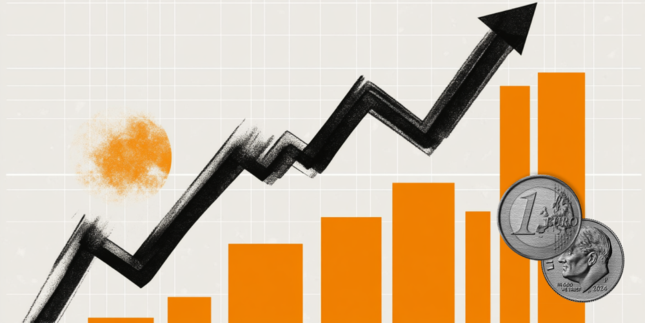- The Euro is trading sideways with a sourer market sentiment supporting the US Dollar.
- A softer-than-expected US PPI on Friday revived hopes of Fed cuts and hurt the US Dollar
- Trading is light on Monday, with US markets closed on bank holiday.
The Euro (EUR) is moving without a clear direction on Monday. In the absence of first-tier macroeconomic releases, the knee-jerk reaction in European markets, dipping into negative territory, and the downbeat Eurozone data are weighing on the Common currency.
With the US markets closed for Martin Luther King's birthday, the US Dollar is picking some bids as the market shifts its focus away from last Friday’s soft US PPI data. The Dollar Index (DXY), however, remains trapped within last week’s trade range, unable to put a significant distance from late December lows.
Traders welcomed December’s unexpected decline in the US Producer Prices Index (PPI), on Friday. These figures have heightened bets for Fed easing, despite the the uptick in the CPI figures seen earlier in the week and Fed officials’ warnings about excessive optimism. US Treasury Yields retreated, with the benchmark 10-year yield dipping below the 4% level, and the US Dollar eased, to close the week practically flat.
This week, the focus will be on the Eurozone Consumer Price Index (CPI) and US Retail Sales data. These figures will give further insight into the Eurozone and US economic outlook and might help the EUR/USD to break the horizontal range that is constraining price action.
Daily digest market movers: Euro gives away gains as the US Dollar picks up on a sourer risk environment
- The Euro is marginally higher in a calm session on Monday with hopes of Fed cuts weighing on the US Dollar.
-
Eurozone Industrial Production contracted at a 0.3% pace, as expected in December. Year-on-year, production declined 6.8%, well beyond the 5.9% expected.
-
In Germany, the Preliminary GDP has declined 0.3% in the year, down from the previous 1.8% increase.
- On Friday, US PPI declined 0.1% in December on month, against expectations of a 0.1% increase, which has revived hopes of Fed cuts in March.
- The CME Group FedWatch Tool shows a more than 70% chance that the Fed will lower interest rates in March and a 75% possibility of another rate cut in May.
- Investors have ignored the uptick in the CPI and Fed officials’ comments affirming that it is still too early for rate cuts.
- European Central Bank (ECB) President Christine Lagarde showed an unprecedented bearish tone on Friday signaling the end of interest rate hikes, which is weighing on Euro bulls.
- ECB Board member and Governor of the Bank of Ireland, Philip Lane, has discarded any rate cut until June in an interview over the weekend. This has given some support to the Euro.
- In the Eurozone calendar on Wednesday, Eurostat is expected to confirm that the CPI accelerated to 2.9% year-on-year in December from 2.5% in November, while the Core inflation eased to a 3.4% yearly pace from the previous 3.6% rate.
- Also on Wednesday, US Retail Sales are expected to have increased in December, which might limit the US Dollar weakness.
Technical Analysis: EUR/USD maintains the broader positive trend
The EUR/USD keeps trading within a narrow range on Monday, with price action trapped between the 4-hour 100 and 200 SMAs, with the RSI flattening around the 50 level, which suggests a lack of clear direction.
The broader trend, however, remains positive, with price action reflecting higher highs and higher lows. Immediate support remains at 1.0930, where the 4-hour 200 SMA meets the price. Below here, the trendline support from early November lows, now around 1.0900, and the January 5 low at 1.0875 are likely to challenge bears.
On the upside, the pair needs to breach a strong resistance at 1.1000, where the pair has printed a double top. This level is closing the path toward a minor resistance at 1.1075, ahead of December’s peak at 1.1145.
Euro price today
The table below shows the percentage change of Euro (EUR) against listed major currencies today. Euro was the strongest against the .
| USD | EUR | GBP | CAD | AUD | JPY | NZD | CHF | |
| USD | -0.01% | 0.04% | 0.04% | 0.36% | 0.36% | 0.58% | 0.06% | |
| EUR | 0.01% | 0.04% | 0.05% | 0.38% | 0.37% | 0.60% | 0.06% | |
| GBP | -0.04% | -0.05% | 0.00% | 0.33% | 0.32% | 0.53% | 0.03% | |
| CAD | -0.03% | -0.04% | 0.00% | 0.34% | 0.31% | 0.54% | 0.02% | |
| AUD | -0.37% | -0.38% | -0.32% | -0.33% | -0.01% | 0.22% | -0.32% | |
| JPY | -0.35% | -0.37% | -0.44% | -0.32% | 0.01% | 0.24% | -0.29% | |
| NZD | -0.58% | -0.60% | -0.56% | -0.55% | -0.23% | -0.23% | -0.53% | |
| CHF | -0.06% | -0.07% | -0.03% | -0.02% | 0.32% | 0.31% | 0.52% |
The heat map shows percentage changes of major currencies against each other. The base currency is picked from the left column, while the quote currency is picked from the top row. For example, if you pick the Euro from the left column and move along the horizontal line to the Japanese Yen, the percentage change displayed in the box will represent EUR (base)/JPY (quote).
German economy FAQs
What is the effect of the German Economy on the Euro?
The German economy has a significant impact on the Euro due to its status as the largest economy within the Eurozone. Germany's economic performance, its GDP, employment, and inflation, can greatly influence the overall stability and confidence in the Euro. As Germany's economy strengthens, it can bolster the Euro's value, while the opposite is true if it weakens. Overall, the German economy plays a crucial role in shaping the Euro's strength and perception in global markets.
What is the political role of Germany within the Eurozone?
Germany is the largest economy in the Eurozone and therefore an influential actor in the region. During the Eurozone sovereign debt crisis in 2009-12, Germany was pivotal in setting up various stability funds to bail out debtor countries. It took a leadership role in the implementation of the 'Fiscal Compact' following the crisis – a set of more stringent rules to manage member states’ finances and punish ‘debt sinners’. Germany spearheaded a culture of ‘Financial Stability’ and the German economic model has been widely used as a blueprint for economic growth by fellow Eurozone members.
What are German Bunds?
Bunds are bonds issued by the German government. Like all bonds they pay holders a regular interest payment, or coupon, followed by the full value of the loan, or principal, at maturity. Because Germany has the largest economy in the Eurozone, Bunds are used as a benchmark for other European government bonds. Long-term Bunds are viewed as a solid, risk-free investment as they are backed by the full faith and credit of the German nation. For this reason they are treated as a safe-haven by investors – gaining in value in times of crisis, whilst falling during periods of prosperity.
What are German Bund Yields?
German Bund Yields measure the annual return an investor can expect from holding German government bonds, or Bunds. Like other bonds, Bunds pay holders interest at regular intervals, called the ‘coupon’, followed by the full value of the bond at maturity. Whilst the coupon is fixed, the Yield varies as it takes into account changes in the bond's price, and it is therefore considered a more accurate reflection of return. A decline in the bund's price raises the coupon as a percentage of the loan, resulting in a higher Yield and vice versa for a rise. This explains why Bund Yields move inversely to prices.
What is the Bundesbank?
The Bundesbank is the central bank of Germany. It plays a key role in implementing monetary policy within Germany, and central banks in the region more broadly. Its goal is price stability, or keeping inflation low and predictable. It is responsible for ensuring the smooth operation of payment systems in Germany and participates in the oversight of financial institutions. The Bundesbank has a reputation for being conservative, prioritizing the fight against inflation over economic growth. It has been influential in the setup and policy of the European Central Bank (ECB).
Information on these pages contains forward-looking statements that involve risks and uncertainties. Markets and instruments profiled on this page are for informational purposes only and should not in any way come across as a recommendation to buy or sell in these assets. You should do your own thorough research before making any investment decisions. FXStreet does not in any way guarantee that this information is free from mistakes, errors, or material misstatements. It also does not guarantee that this information is of a timely nature. Investing in Open Markets involves a great deal of risk, including the loss of all or a portion of your investment, as well as emotional distress. All risks, losses and costs associated with investing, including total loss of principal, are your responsibility. The views and opinions expressed in this article are those of the authors and do not necessarily reflect the official policy or position of FXStreet nor its advertisers. The author will not be held responsible for information that is found at the end of links posted on this page.
If not otherwise explicitly mentioned in the body of the article, at the time of writing, the author has no position in any stock mentioned in this article and no business relationship with any company mentioned. The author has not received compensation for writing this article, other than from FXStreet.
FXStreet and the author do not provide personalized recommendations. The author makes no representations as to the accuracy, completeness, or suitability of this information. FXStreet and the author will not be liable for any errors, omissions or any losses, injuries or damages arising from this information and its display or use. Errors and omissions excepted.
The author and FXStreet are not registered investment advisors and nothing in this article is intended to be investment advice.
Recommended content
Editors’ Picks

AUD/USD: Momentum favours further gains
In line with the broad recovery in the risk-linked complex, AUD/USD left behind a two-day negative streak and resumed its uptrend towards the 0.6400 region, always on the back of the resurgence of quite a strong downside pressure hitting the US Dollar on Thursday.

EUR/USD: Extra advances appear in the pipeline
EUR/USD followed the widespread improved sentiment in the risk-linked galaxy and managed to set aside two daily drops in a row and refocus on the upper end of its recent range around the 1.1400 zone on Thursday.

Gold price climbs past $3,300 on uncertainty about trade and weak USD
Gold snaps two-day losing streak, gaining 1.5% on fresh trade war fears. Trump softens tariff talk, but China denies negotiations and demands full rollback. Fed rate cut bets rise as yields drop and economic uncertainty builds.

Ondo Finance hits $3B market cap as CEO Nathan Allman meets SEC to discuss tokenized US securities
Ondo Finance met with officials of the SEC and the law firm Davis Polk to discuss the regulation of tokenized US securities. Topics included registration requirements, broker-dealer rules and proposed compliant models for tokenized securities issuance.

Five fundamentals for the week: Traders confront the trade war, important surveys, key Fed speech Premium
Will the US strike a trade deal with Japan? That would be positive progress. However, recent developments are not that positive, and there's only one certainty: headlines will dominate markets. Fresh US economic data is also of interest.

The Best brokers to trade EUR/USD
SPONSORED Discover the top brokers for trading EUR/USD in 2025. Our list features brokers with competitive spreads, fast execution, and powerful platforms. Whether you're a beginner or an expert, find the right partner to navigate the dynamic Forex market.



